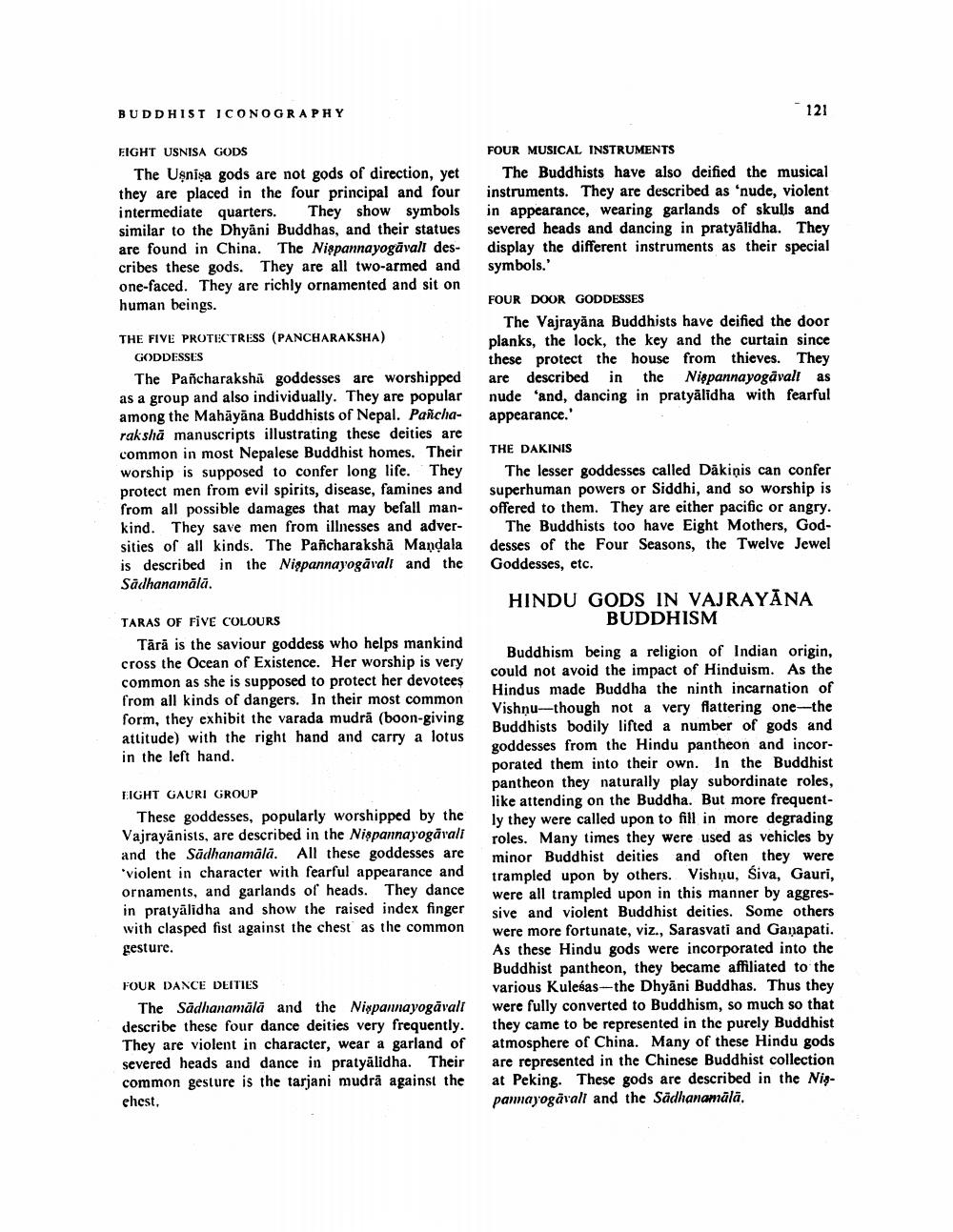________________
BUDDHIST ICONOGRAPHY
121
EIGHT USNISA GODS
The Usnisa gods are not gods of direction, yet they are placed in the four principal and four intermediate quarters. They show symbols similar to the Dhyani Buddhas, and their statues are found in China. The Nispannayogāvali describes these gods. They are all two-armed and one-faced. They are richly ornamented and sit on human beings.
FOUR MUSICAL INSTRUMENTS
The Buddhists have also deified the musical instruments. They are described as 'nude, violent in appearance, wearing garlands of skulls and severed heads and dancing in pratyālidha. They display the different instruments as their special symbols.'
FOUR DOOR GODDESSES
The Vajrayana Buddhists have deified the door planks, the lock, the key and the curtain since these protect the house from thieves. They are described in the Nigpannayogavalt as nude 'and, dancing in pratyālidha with fearful appearance.'
THE FIVE PROTECTRESS (PANCHARAKSHA) GODDESSES
The Pancharakshā goddesses are worshipped as a group and also individually. They are popular among the Mahāyāna Buddhists of Nepal. Pancha- rakshä manuscripts illustrating these deities are common in most Nepalese Buddhist homes. Their worship is supposed to confer long life. They protect men from evil spirits, disease, famines and from all possible damages that may befall mankind. They save men from illnesses and adver- sities of all kinds. The Pancharaksha Mandala is described in the Nigpannayogāvalt and the Sadhanamālā.
THE DAKINIS
The lesser goddesses called Däkinis can confer superhuman powers or Siddhi, and so worship is offered to them. They are either pacific or angry.
The Buddhists too have Eight Mothers, Goddesses of the Four Seasons, the Twelve Jewel Goddesses, etc.
HINDU GODS IN VAJRAYANA
BUDDHISM
TARAS OF FIVE COLOURS
Täră is the saviour goddess who helps mankind cross the Ocean of Existence. Her worship is very common as she is supposed to protect her devotees from all kinds of dangers. In their most common form, they exhibit the varada mudrā (boon-giving attitude) with the right hand and carry a lotus in the left hand.
EIGHT GAURI GROUP
These goddesses, popularly worshipped by the Vajrayānists, are described in the Nigpannayogávali and the Sädhanamālā. All these goddesses are 'violent in character with fearful appearance and ornaments, and garlands of heads. They dance in pratyālidha and show the raised index finger with clasped fist against the chest as the common gesture.
Buddhism being a religion of Indian origin, could not avoid the impact of Hinduism. As the Hindus made Buddha the ninth incarnation of Vishnu--though not a very flattering one-the Buddhists bodily lifted a number of gods and goddesses from the Hindu pantheon and incorporated them into their own. In the Buddhist pantheon they naturally play subordinate roles, like attending on the Buddha. But more frequently they were called upon to fill in more degrading roles. Many times they were used as vehicles by minor Buddhist deities and often they were trampled upon by others. Vishnu, Siva, Gauri, were all trampled upon in this manner by aggressive and violent Buddhist deities. Some others were more fortunate, viz., Sarasvati and Ganapati. As these Hindu gods were incorporated into the Buddhist pantheon, they became affiliated to the various Kulesas--the Dhyāni Buddhas. Thus they were fully converted to Buddhism, so much so that they came to be represented in the purely Buddhist atmosphere of China. Many of these Hindu gods are represented in the Chinese Buddhist collection at Peking. These gods are described in the Nispammayogåvall and the Sadhanamālā.
FOUR DANCE DEITIES
The Sadhanamālā and the Nixpannayogávali describe these four dance deities very frequently. They are violent in character, wear a garland of severed heads and dance in pratyālidha. Their common gesture is the tarjani mudră against the ehest,




